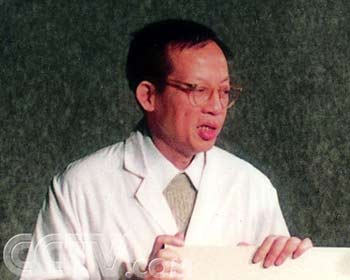∞(无穷)骑乐(yuè)
上帝不响。如歌单车......Never too late for a happy childhood (young-at-heart is so easy — pedaling a revolution from within)...
| Wang Xuan: Modern Bi Sheng | |||||||
 With the invention of a computerized laser photocomposition system for Chinese character typesetting, he proved to the world that Chinese people could independently realize the historic change from letterpress printing to electronic publishing. His invention is also described as the "second invention of the printing system for Chinese character after Bi Sheng's invention of movable clay type in the Northern Song Dynasty (960-1127), which ushered in a revolution in the history of printing. He had been often dubbed the "Modern Bi Sheng". Despite his achievements in computer sciences and his glorious titles as the academician with both the Chinese Academy of Sciences and Chinese Academy of Engineering, Wang Xuan, who died of illness Monday in Beijing at the age of 69, is more remembered by his former peers and students as a person with an enterprising and hard-working spirit and one who is easy-going and amicable. "Modern Bi Sheng" Revolutionized Chinese Character Printing "His invention marked an 'industrial revolution' in the history of printing and a great leap forward in the press industry of Born in February of In August 1974, Due to backward computer technologies and poor research conditions at that time, Wang and his colleagues faced many difficulties in developing the photo-typesetting system. "Many workers with the program felt frustrated by the many failures, but Wang often encouraged us to continue. And he often worked all nightlong for days," said Kang, with the Xinhua News Agency printery. "Wang also tried every means to guarantee that we would have a good rest after work and he often worried about our safety, especially female workers, going back home in the night," Kang recalled. Wang had been in poor health, but he was extremely diligent and devoted whole-heartedly to the photo-typesetting system for Chinese characters, Kang said. Xinhua News Agency became the first beneficiary of the laser photo typesetting by computer in 1985, and the Economic Daily became the first newspaper on the Chinese mainland to adopt the technology in 1987. Wang also helped create a Chinese-language newspaper editing and publishing system using large computer terminals, a Chinese-language laser typesetting system for color printing and a management system for news collection and editing, among others.
An "Ordinary Person" Due to his outstanding achievements, Wang won numerous awards: appraised the top ten science and technology achievements in China in 1985; was named one of middle and young experts who made eminent contributions to national science and technology in 1986; awarded Tan Kah-kee Science and Technology Prize in 1990; and awarded 1995 prize for advancement in science and technology by the Ho Leung Ho Lee Foundation. But Wang had lived a very simple life, said Xiao Jianjun, a student of Wang and a member of the board of directors of the Founder Group of the Peking University. Given his outstanding achievements and contributions to Wang usually wore casual suits and only put on Western-style clothes when he was interviewed or met with foreign guests, said Xiao. He rode a bicycle to work and never rode a car specially arranged for him by the Founder Group, when he worked at the company, Xiao said. "Wang was unassuming and amicable, and helped and cultivated young people with a noble heart," said Liu Qiuyun, deputy head of the computer Liu said, Wang Xuan often used his bonuses to award and inspire young people who made marked progress and outstanding contributions in research. In 2002, Wang used his 9 million yuan (more than US$1 million) bonus to establish the "Wang Xuan Science Research Fund" to support the research work of the computer institute of the Peking University. He invented the laser photo typesetting system for Chinese characters, but he did not name system with his own name. (Xinhua News Agency February 17, 2006)
当代毕昇王选:一直骑自行车上班 激光照排之父王选——全国政协副主席、中国科学院院士、中国工程院院士、第三世界科学院院士,北大方正控股有限公司首席科技顾问。 作为汉字激光照排系统的发明者,他推动了中国印刷技术的第二次革命,被称为“当代毕昇”。 1975年,已经38岁的王选还是北京大学的一名普通助教。然而就是这位重病十年、只能拿劳保的小助教,在汉字精密照排的科研项目上,却带领一个团队大胆选择了当时处于最前沿的第四代激光照排系统的研制方向。1992年,他们发明的汉字激光照排系统占领了国内99%和国外80%的中文电子排版系统市场。这一发明也把我国印刷业的发展历程缩短了整整半个世纪,从而创造了一个汉字印刷革命的神话。 昨日,北京大学连夜为王选设立灵堂 竞报 图 告别了此生最后一个上元节,他平静地闭上了眼睛。昨天上午11时03分,一个被称为“当代毕昇”的69岁老人离我们远去了。 “从某种程度上讲,他的成就造就了中国纸质媒体的传奇,每一位从中受益的媒体人都应该向他致敬,读报的人都该记住他的名字。”在得知他的死讯后,被公认为中国报业发展核心城市的广州,一位都市报总编这样评价他。 全国政协副主席、中国科学院院士、中国工程院院士、第三世界科学院院士、北京大学教授王选,以他的学术成果和世人对他的尊敬为自己的人生划上了句号。 一名熟悉王选教授的北大老师告诉记者,王选老师的身体状况一直不是太好,中午获知噩耗,北大师生都十分沉痛,他的辞世,是北大重大的损失。北大已经成立以许智宏校长为主任的治丧办公室,将在北大百周年纪念讲堂纪念大厅布设灵堂供师生员工吊唁,北大新闻网已专门开设了王选院士的网上悼念馆。 北京大学东门对面,屹立着王选一手带大的“孩子”:北大方正。在方正大厦,记者依然能看到王选身后留下的恢弘事业和集团上下对他一成不变的敬重。一层大堂展览厅中央位置,醒目地摆放着2001年江泽民为获得最高科学技术奖的王选颁奖的照片。 医院:死因为消化道出血 昨天下午三点多,记者赶到了王选生前所住的协和医院。 由于王选是协和医院的VIP病人,虽然好几家媒体的记者都在追问,有关王选的病情,医院并未透露多少内容。不过,记者在协和医院住院楼地下二层的太平间里见到了八宝山殡仪馆服务站的工作人员。据这位李师傅说,王选是中午1点左右送来的,当时一起来的有几十个人。“听他们说好像是要在周日将遗体运走。”记者在“存放尸体手续存根”上看到:王选,69岁,死亡原因:消化道出血。 北大开设网上悼念馆 本报讯 王选院士的追悼活动将从后天开始,灵堂正在紧锣密鼓的设置中。 昨天下午三点,记者赶到北大了解到,王选院士的灵堂设在北大百年纪念讲堂。下午五点开始,工作人员布置灵堂,工作人员用长16米、高6米的铁架子做一个矩形框,工作人员介绍,矩形框以白布为底,再铺上黑布用于贴挂照片和条幅。据了解,灵堂将于今天设置完毕,预计于明天上午9点开始开放灵堂。 据了解,王选的逝世甚至使北大原本为镜春园、朗润园以及全斋区域的整治工作的说明会都因此而推迟举行。但北大还是当即就成立了以北大校长许智宏院士为主任的治丧办公室,昨天下午,北大党委常务副书记吴志攀还主持召开了为时一个多小时的会议,重点讨论了灵堂的布设工作和细节,细节甚至包括花圈的数量、挽联等方方面面。 万余人网上留言悼念 昨天12时,北大得知王选教授病逝的消息后,立刻开设了网上悼念馆,从下午2点40分,网上悼念馆出现第一篇帖子开始,跟帖发表的留言就源源不断,无论是北大的师生还是北大方正的员工,都在这个平台上诉说着各自对王选院士的哀悼之情。 北大新闻中心的工作人员告诉记者,从下午2点网上悼念馆开通至晚上10点,已经有万人在网上悼念馆吊唁王选教授。 “这个速度是惊人的,充分体现出王选院士在人们心目中的地位”北京大学新闻发言人赵为民表示。 其他门户网站也纷纷开设专题,来缅怀和悼念这位在IT和学术界都令人尊敬的前辈。 中学母校将举行追悼活动 “噩耗!噩耗!太突然了!太突然了!”王选母校南洋模范中学的校长高屹听到王选去世的消息难抑悲痛。高屹称,目前上海南洋模范中学还没有好好策划对王选的追悼活动,但学校已经开始收集王选与该校的点滴材料,并把所有的影像资料编辑成短片,将在全校进行播放。另外,该校会在近日安排对王选的一系列追悼活动。 ——回忆—— 倪光南院士: 他的创新精神激励我们 惊闻王选院士不幸逝世,噩耗传来,悲痛万分。我与王选院士相识已有20多年,可以说是老战友了。记得最近的一次见面是在2002年的中文信息学会会议上,那竟是我最后一次同他见面了。 王选院士最突出的是他的创新精神。王选院士既是优秀的科学家,又是杰出的企业家;他既有精湛深厚的学术造诣,又有坚毅不拔的实干精神。今天,虽然王选院士不幸早逝,但他的精神,他的业绩,将永远激励着我们,我们一定要实现王选院士的未了心愿,将王选院士的自主创新精神发扬光大。 老校友: 他一直骑着自行车上班 北大电子系教授金东瀚昨天听到王选病逝的消息后,大吃一惊。两位老人不仅是大学同级的校友,而且金东翰的妻子和王选妻子是师生关系,来往较密切。 在金东翰的印象里,王选虽然名气和财富都超过常人,但一直是个特别节俭,特别谦虚的人。他举了三例:王选完全可以住进新建的140多平米的教授楼,但他一直都没住,表示对现有的住房条件已经很满足了,依然和妻子住在80多平米的老楼里。王选是方正集团的领导,集团也很早就给他配了车,但是他一直是骑自行车上班。王选的衣着总是很普通,平时见了同事、同学和朋友没有一点架子,总是热情的打招呼。 本报综合报道 |






